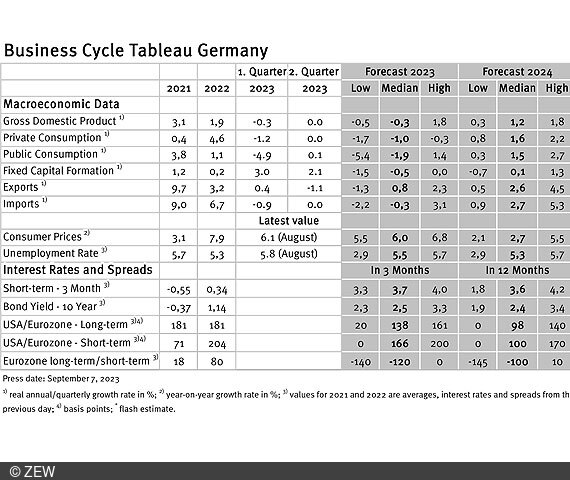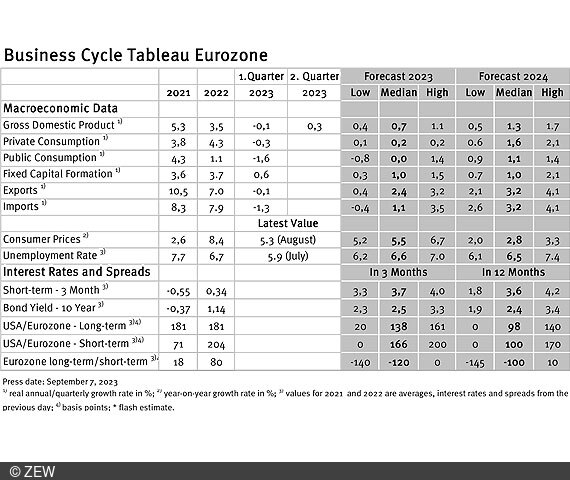No Change for the Better
Business Cycle Tableaus by ZEW and Börsen-ZeitungEconomic Experts Confirm that the German Economy Continues to Be Experiencing a Weak Period
According to economic experts, Germany’s economy has not yet found its way out of the trough. Their forecast for this year continues to indicate a decline in economic performance. Germany is thus lagging far behind the rest of the eurozone, in which the economy is expected to develop somewhat better overall than previously expected. In the coming year, however, the German economy should be able to catch up again. The high inflation rate is also not expected to considerably retreat back towards its target until 2024. These are the results of the business cycle tableaus by ZEW Mannheim and the German daily newspaper, Börsen-Zeitung.
As in the previous month, the quarterly growth figures for Germany’s real gross domestic product (GDP) are reported at minus 0.3 per cent for the first quarter and 0 per cent for the second quarter. The zero growth in the second quarter is at least partly explained by the fact that private consumption, government spending and imports each stagnated in the second quarter. Along the same lines, the experts’ forecasts have also not changed. As in August, they currently forecast a decline in Germany’s real GDP of 0.3 per cent for 2023 and an increase of 1.2 per cent for 2024.
Germany falls further behind in the eurozone
The quarterly growth figures for the euro area remain the same, with a reported 0.1 per cent for the first quarter and 0.3 per cent for the second quarter, demonstrating a continued slightly higher rate of economic growth in the eurozone as compared to Germany. Growth prospects have also only shown negligible signs of change. While the experts have revised their growth forecast for 2023 upwards by 0.1 percentage points to now 0.7 per cent, for 2024, a 1.3 per cent economic growth rate is assumed, just as in August.
In a comparison of the GDP forecasts for Germany and the euro area, the slightly improved growth expectations for the euro area mean that, according to experts, Germany will continue to fall behind the rest of the eurozone in 2023. In the year 2024, however, economic growth rates for Germany and the wider eurozone are expected to be very similar.
Inflation rate is just barely slowing down
The observed differences in economic growth between Germany and the entire eurozone are for the most part manifested through the inflation rates. In August, inflation stood at 6.1 per cent for Germany and 5.3 per cent for the eurozone. While inflation in the euro area remains constant, inflation in Germany has dropped 0.1 per cent since the previous month.
The outlook for the year 2023 is more optimistic for the eurozone than it is for Germany. Looking at the entire year, average inflation is expected to be around 6.0 per cent for Germany and 5.5 per cent for the euro area. In 2024, experts predict an inflation rate of 2.7 per cent for Germany and 2.8 per cent for the euro area. Thus, experts anticipate only marginal differences between Germany and the eurozone, as well as a considerable downward shift in inflation rates, approaching the target of the European Central Bank.
No change in monetary policy
Monetary policy prospects have remained unchanged since August. Experts do not expect a relaxation in monetary policy or an upward movement of short-term interest rates. Long-term interest rates are anticipated to remain well below the 3-month rates in the next 12 months.
Business Cycle Tableaus by ZEW and Börsen-Zeitung
In cooperation with Börsen-Zeitung, ZEW has been publishing monthly business cycle tableaus for Germany and the eurozone with economic key figures and forecasts since 2013. Numerous banks and institutes publish reports on the current and prospective economic situation at different intervals. The information relevant for the tableau is filtered out of these publications to compute a median, minimum and maximum of the available forecasts for the current and subsequent year.
The monthly tableaus show current GDP forecasts, its main components, consumer prices, industrial production, unemployment rate, short- and long-term interest rates, and interest rate spreads. The focus of the tableaus lies on national business cycle reports, which are complemented with forecasts from international banks and institutes. The tableau for the eurozone is enhanced by data from European banks and institutes.

